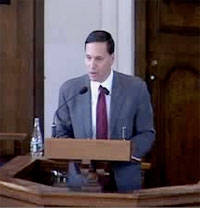Presidential Address: Ron Liebowitz reports on progress, plans and a vision for the future

MIDDLEBURY, Vt.—Stepping up to greet an expectant audience of students, faculty and staff in a nearly packed Mead Chapel on Friday afternoon, February 12, Middlebury College President Ron Liebowitz spoke with confidence and cautious optimism as he assessed the last 18 months and recounted where we’ve been, how we’re doing and what we can do to work together toward a more balanced future.
Saying recent financial challenges looked more like the Himalayas than the familiar and comforting Green Mountains, Liebowitz reviewed the College’s efforts from the initial hiring and salary freezes in 2008 to the unprecedented level of transparency that followed as the entire campus community was encouraged to work collectively on solving the recession-related issues that rose fast and furiously to the forefront.
Beginning with a frank acknowledgment of an excessive past, Liebowitz recalled the “arms race” of the late 1990s, during which Middlebury, along with many of its peers, became heavily invested in enhancing the college experience with state-of-the-art facilities and technology, additional academic programs, residential amenities—and the increased faculty and staff needed to support the broadening infrastructure.
While the changes during that time certainly contributed to improving the status and reputation of Middlebury as a leader among liberal arts colleges, Liebowitz said, the model became unsustainable in the face of a worldwide recession. Due to administrative decisions, the size of the staff had increased from 580 in 1996 to more than 1,000 in 2008. And since personnel has always been the College’s biggest cost, a different approach to reconciling expenditures and revenue was necessary.
Quotable:
“I am happy to say that, barring any unexpected deep decline in the economy—and I mean a really deep decline—staff layoffs are now off the table.”
With an appreciative word of thanks—the first of many throughout his address—Liebowitz credited the members of the Budget Oversight Committee (BOC) with taking on that task. Made up of people from all segments of the College community, the BOC furthered Middlebury’s efforts at transparency by organizing multiple open meetings, instituting an online appeal for suggestions and recommendations—of which they received more than 1,000, many of them implemented—and a comprehensive survey of students, faculty, staff and alumni to provide their perspective of the value of everything from College benefits to the hours of operation at The Grille. Participation in all of these opportunities was remarkable, with nearly 2,000 survey respondents and many full-house meetings that generated lively and relevant discussions about potential institutional changes.
Liebowitz acknowledged that Middlebury’s approach had certainly been more “slow and tortuous” than that of many other schools, from some of which there has been grim news in recent days of layoffs and other cutbacks. But he believes the focus on a more time-consuming and intricate staffing analysis, as opposed, for example, to the reliance on immediate layoffs, has made for a stronger community more invested in long-term solutions. He received rousing applause and cheers when he announced that not only were “layoffs off the table,” but that he also plans to present the Board of Trustees next week with a plan that will lead to balanced budgets through 2015.
Having congratulated and thanked the audience for “our collective and remarkable progress,” Liebowitz’s words turned to cautious optimism as he reminded people that the old model of “business as usual” is long gone. In addition to a balanced budget, he is planning to present the board with a lengthy and specific list of policy and long-term financial model recommendations, as well as a significant shift in perspective in considering the potential revenue increases that Middlebury’s graduate and special academic programs can provide.
From retaining policies such as need-blind admissions for domestic students, a student-faculty ratio of 9:1, and a limit of 850 full-time equivalents for the College’s staff, to developing policies for a more limited operating budget and an increase in the student body to 2,450, Liebowitz delivered a robust list of changes.
Quotable:
“It is easy, especially in challenging times, to pull back, withdraw, hunker down, and see only the risks that come with doing things differently. But what we need most right now is the opposite: to adopt new assumptions and methods of planning our future; to be willing to re-think what we do here as positions are reduced and responsibilities are shifted around; to see success anywhere across the institution as a success for each and all of us; to embrace the programmatic richness of this institution here in Vermont along with the 40 or so other places around the world in which it operates; and to see the possibilities in new opportunities and how they can support and strengthen, rather than threaten, the very best of what we value here on this campus.”
In considering future revenue sources, Liebowitz pointed to the College’s unique list of internal assets. By capitalizing on the array of resources available through the College’s graduate and special academic programs—including the C.V. Starr-Middlebury Schools Abroad, the Bread Loaf programs, the Summer Language Schools, the Middlebury-Monterey Language Academy and the Monterey Institute of International Studies—Liebowitz believes the College can not only reinforce its reputation as the leader in the human-intensive educational experience that is fundamental to Middlebury, but also introduce the concept in the for-profit arena. Liebowitz reminded listeners that off-the-beaten-path suggestions of yore—such as admitting women or creating an environmental studies major—might never have come to pass had people not been willing to adopt new assumptions.
In closing, Liebowitz recalled the inspirational teaching, far-reaching support and lifelong friendships that have been the hallmarks of Middlebury College for nearly 210 years. And he encouraged the entire college community to join him in taking a considerable step forward with renewed pride, and a healthy dose of creativity and optimism.

